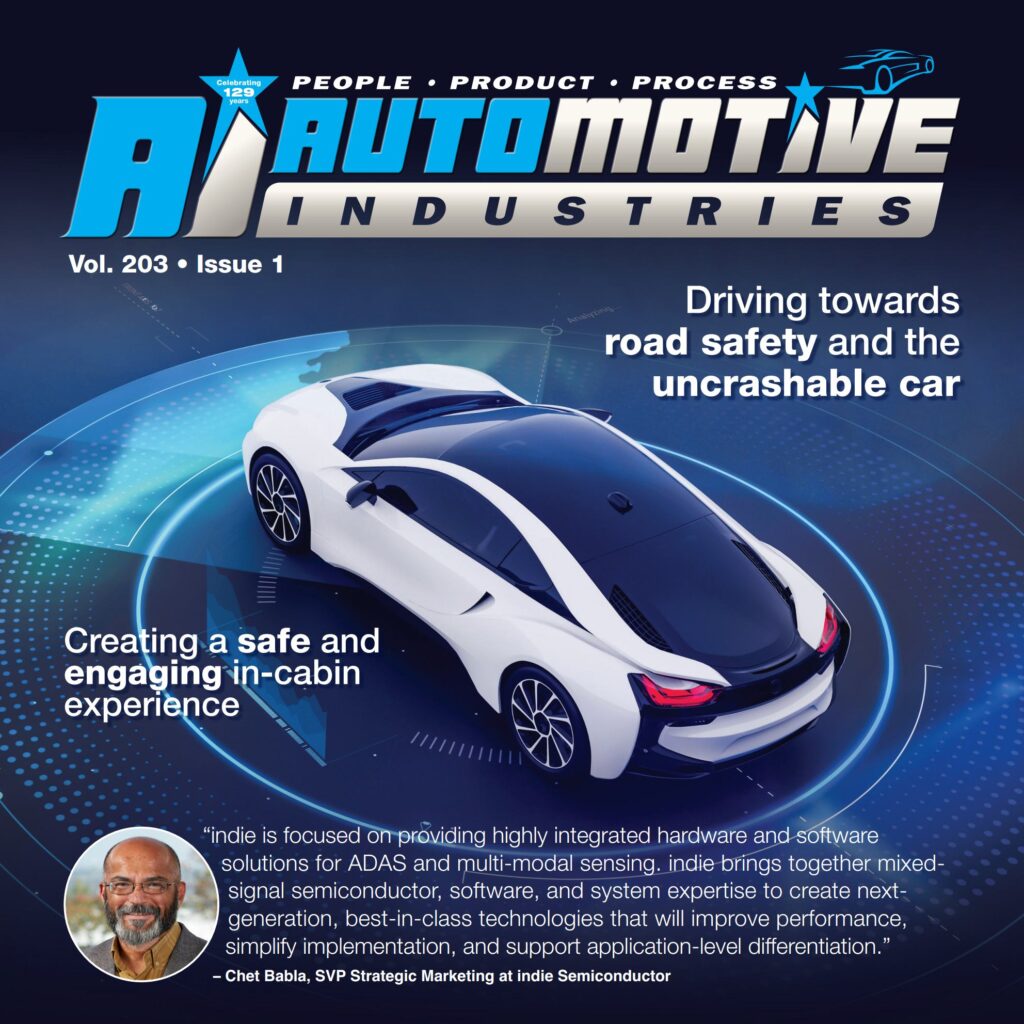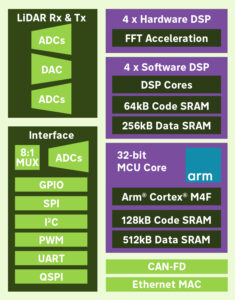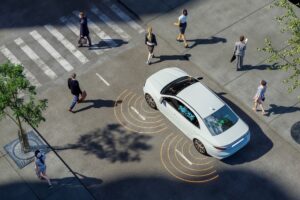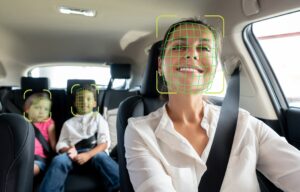
Automotive safety has been a persistent challenge in the industry, with fatal crashes claiming lives at an alarming rate worldwide. In the pursuit of safer roads, indie Semiconductor emerges with a bold vision: to enable the creation of uncrashable cars. Chet Babla, the Senior Vice President of Strategic Marketing at indie Semiconductor, shares insights into the company’s overarching strategy and its mission to revolutionize automotive safety.
Motor vehicle crashes remain a leading cause of death, prompting regulators and original equipment manufacturers (OEMs) to envision uncrashable cars as the future of road safety. However, achieving this vision entails overcoming various technological and commercial hurdles. At indie Semiconductor, the focus is squarely on addressing these challenges and delivering a safe yet enjoyable driving experience.
Setting itself apart from other semiconductor vendors, indie Semiconductor is a ‘pure-play’ Autotech specialist, dedicating its expertise solely to the automotive sector. The company’s product portfolio targets three key automotive megatrends: driver safety and automation, in-cabin user experience, and electrification.  Through innovations like multi-modal sensing, customizable lighting designs, and advanced charging systems, indie Semiconductor aims to tackle current and future challenges confronting automotive OEMs and Tier 1 suppliers.
Through innovations like multi-modal sensing, customizable lighting designs, and advanced charging systems, indie Semiconductor aims to tackle current and future challenges confronting automotive OEMs and Tier 1 suppliers.
The rise in global car ownership has unfortunately paralleled an increase in risk to all road users. Chet Babla identifies various contributors to this trend, including distracted and drowsy driving, an aging population, and reckless behavior on the roads. While legislative and enforcement measures aim to address these issues, indie Semiconductor sees a pivotal role for Advanced Driver-Assistance Systems (ADAS) and increased driver automation in reducing fatalities and injuries.
As a leader in radar, LiDAR, and vision technologies, indie Semiconductor emphasizes the integration of these sensor modalities to enhance driver visibility and overall safety.
Cameras, radar, and LiDAR each offer unique benefits, and leveraging their combined capabilities is crucial for achieving the uncrashable car vision. indie Semiconductor’s expertise lies in efficiently processing information from these sensors, optimizing power consumption, and minimizing the overall bill of materials for OEMs.
Navigating the dynamic legislative environment related to car safety presents challenges, but indie Semiconductor remains committed to meeting and exceeding regulatory requirements. With a focus on creating automotive-specific technologies, the company assists OEMs in overcoming obstacles and accelerating the implementation of advanced safety features.
Looking ahead, indie Semiconductor sees a future where reduced fatalities and uncrashable cars become a reality. Through strategic partnerships and innovative solutions, the company aims to push the automotive industry forward, driving towards a safer, more secure future for drivers and passengers worldwide.
Automotive Industries (AI) asked Chet Babla to share insights into the company’s overarching strategy and how indie Semiconductor aims to revolutionize automotive safety.
Babla: Motor vehicle crashes are a leading cause of death in many countries. In the United States alone, crashes kill over 100 people a day. To reduce the number of accidents, injuries and fatalities, regulators and vehicle original equipment manufacturers (OEMs) aspire to the vision of bringing uncrashable cars to market.
But first, OEMs must overcome a variety of technological and commercial challenges.
At indie, we’re focused on addressing these challenges and helping deliver a safe, while also enjoyable, experience. Unlike other semiconductor vendors that deal across multiple markets, indie is a ‘pure-play’ Autotech specialist focused solely on creating technologies for the automotive sector.
Our differentiated product portfolio addresses three key automotive megatrends: driver safety and automation, in-cabin user experience, and electrification. Whether it’s multi-modal sensing for road safety and vehicle automation, customizable exterior and interior lighting designs, advanced in-cabin charging systems or solutions for EVs, each of these focus areas play a role in addressing current and future challenges facing today’s automotive OEMs and Tier 1 suppliers.
AI: With the increase in global car ownership and use, the absolute number of fatal car crashes is unfortunately on the rise. What challenges and factors does indie Semiconductor identify as contributors to this trend, and how does the company plan to address them?
Babla: There are a number of factors at play that are contributing to the continued rise of fatal car crashes. Distracted and drowsy driving have been a growing concern in recent years, especially with the widespread use of smartphones.
Further complicating the situation are inexperienced drivers, an aging population, and drivers who are not fully engaged or alert while behind the wheel. Between impaired driving, speeding and reckless driving, and just a general increase in the number of drivers on the road, the likelihood of a fatal accident has increased over time. Sadly, a number of these deaths are avoidable.

The good news, however, is that multiple national and regional initiatives have been launched in recent decades to address and reduce road-related tragedies.
For example, the World Health Organization and the United Nations General Assembly collaborated to create a plan called the Decade of Action for Road Safety.
But while legislation and enforcement play a key role in achieving the 50% fatalities and injuries reduction goals, additional impact will come from automakers implementing Advanced Driver-Assistance Systems (ADAS) and increasing levels of driver automation.
ADAS applications rely on various sensor modalities to gather data about the vehicle’s exterior and interior environment.
In the context of vehicle motion dynamics, this data needs to be processed to enable timely decision-making and trigger automated safety response actions such as braking, steering, or driver alerts.
This is where the work that we’re doing at indie comes in.
As part of our key offerings, indie is focused on providing highly integrated hardware and software solutions for ADAS and multi-modal sensing. indie brings together mixed-signal semiconductor, software, and system expertise to create next-generation, best-in-class technologies that will improve performance, simplify implementation, and support application-level differentiation.
For example, indie’s iND83301, Surya™ LiDAR SoC, combines indie’s innovative high-speed analog, mixed-signal, DSP and software with TeraXion’s best-in-class laser and sensing technologies. Featuring unrivalled levels of hardware and software integration and representing a major step forward in terms of power, performance, and cost, the solution will allow automotive OEMs and Tier 1 manufacturers to harness the potential of LiDAR for supporting maximum levels of safety in new generations of assisted and self-driving cars.
Working with indie, automotive manufacturers can more easily address the integration of a wide variety of sensor modalities and the efficient processing of ever-higher volumes of data while keeping both system power consumption and the overall bill of materials as low as possible.
And this is only the start of our journey.
We continue to ramp up the development of innovative new technologies that anticipate and address demands from OEMs and Tier 1 customers for step function increases in electronic performance and complexity. Alongside this technology development, we will continue to establish regional ‘Centers of Excellence’ that provide our rapidly expanding customer base with access to the local engineering and field support resources that will help them build the vehicles of the future.
AI: indie Semiconductor emphasizes the use of radar, LiDAR, and vision technologies. How do these sensor modalities work together to overcome potential driver visibility challenges, and what role does integration play in enhancing overall safety?
Babla: Sensing functions can be implemented by different sensor modalities, including cameras, radar and LiDAR (light detection and ranging), to gather data about the vehicle’s environment.
Since each sensor modality has unique benefits, as well as their own shortfalls, the ultimate vision of an uncrashable car will need to leverage multiple sensor modalities in conjunction.
Cameras, or vision sensors, are one of the most widely used vehicle sensors today. In combination with perception algorithms, automotive cameras can mimic human vision in their ability to distinguish between different shapes, colors and types and categories of objects.

As a result, they are widely used for surround and back-up viewing, automatic emergency braking (AEB), pedestrian automatic emergency breaking (PAEB), lane departure warnings (LDW) and lane change assistance (LCA). However, as with human vision, camera vision is easily impaired by challenging environmental conditions like low light, fog and rain. Because of these challenges, OEMs often leverage both camera-based ADAS sensing with radar sensors.
Radar sensors transmit radio waves in a targeted direction (often using beam-steering techniques for added directionality), and analyze the reflected signals to identify the location, speed and direction of an object.
Unlike cameras, radar is generally less affected by unfavorable weather conditions, making it ideal for forward collision warnings (FCW), automatic emergency braking (AEB), and blind spot detection (BSD). While radar is a versatile sensor for general weather use, its resolution is limited to about 4mm for a 77GHz system. For higher precision, LiDAR sensing is now being leveraged and deployed as an additional ADAS sensor by OEMs.
LiDAR is a relatively new and advanced sensor modality that uses infra-red light instead of radio waves to calculate the distance to the object being detected. Infra-red light means that LiDAR has a potential resolution of 2500x finer than a typical radar system. Coherent detection enables per-point velocity determination, allowing additional information to downstream perception algorithms.
Like radar, LiDAR is less impacted by bad weather conditions than cameras, yet it requires significant signal processing to perform its tasks, demanding innovation to limit power, size and cost. Because LiDAR offers better resolution, range and depth perception than cameras and radar, it is becoming a key focus technology for auto OEMs for long range object detection (such as fallen cargo on a highway) and short range, high-precision detection (such as pedestrians in back-up scenarios).

AI: Given the dynamic nature of the automotive industry, how does indie Semiconductor navigate current and forthcoming legislation related to car safety? What impact does this legislative environment have on the development strategies for original equipment manufacturers (OEMs)?
Babla: Regulatory interest in ADAS applications is increasing rapidly. Governments are mandating safety features in new vehicles, such as the U.S. Department of Transportation’s National Highway Traffic Safety Administration (NH
TSA) ADAS-related vehicle safety initiatives and the Vehicle General Safety Regulation introduced by the European Union.
As global initiatives gather momentum and drive cross-stakeholder commitment to action, coupled with additional pressure of safety standards amongst consumers, there’s an increased attention on automotive manufacturers to adapt their own approaches to accelerate the implementation of new technology and advanced safety features into vehicles that meet the needs of regulators and consumers.
Yet this brings tremendous technical challenges for the semiconductor-based electronics systems that pervade modern vehicles. As I mentioned previously, what sets indie a part is our sole focus on creating technologies for the automotive sector.
We’re helping OEMs and Tier 1 customers to build the vehicles of the future and will meet and exceed any relevant regulatory requirements that impact or can be enabled by the underlying semiconductor technology that we develop.
AI: The integration of various sensor modalities is crucial. How does indie Semiconductor manage to efficiently process this information to improve power consumption, and what measures are taken to keep the overall bill of materials as low as possible?
Babla: The ultimate vision of an uncrashable car will need to leverage the benefits of multiple sensor modalities to witness success. As I mentioned above, indie brings together mixed-signal semiconductor, software, and system expertise to create next-generation, best-in-class technologies that will improve performance, simplify implementation, and support application-level differentiation.
Working with indie, automotive manufacturers can more easily address the integration of a wide variety of sensor modalities and the efficient processing of ever-higher volumes of data while with low cost and high-power efficiency that smart semiconductor integration can bring.

AI: Bringing uncrashable cars to market presents significant challenges for OEMs. What specific challenges does indie Semiconductor recognize in this regard, and how does the company assist OEMs in overcoming these obstacles?
Babla: One challenge that we’re seeing is a lack of agreement about the ‘right’ deployment approach of distributed-, domain-, zonal- and centralized-compute architecture in the age of the software-defined vehicle. Sensor modalities must be integrated into the vehicle’s overall electrical and electronic (E/E) architecture.
There are multiple trade-offs to consider when evaluating E/E architecture and how much processing and decision-making intelligence (i.e., “think” and “act”) is added to the sensing edge versus centralized processing.
However, each automotive OEM has a unique view of the E/E platform scalability priorities and legacy constraints that need to be considered. While the debate continues, indie believes strongly that distributed intelligence will play a fundamental role in the journey to creating the uncrashable car.
Such distributed intelligence, based on integrating some degree of processing capability into the vehicle sensing modalities, offers significant flexibility and will allow us to address the challenges noted above by deploying highly scalable automated driver safety solutions, regardless of the E/E architecture.
AI: Drawing from your extensive experience in the technology industry, how does indie Semiconductor leverage its expertise to support the development of cutting-edge automotive technologies, especially in the context of ADAS and autonomous driving?
Babla: Our mission at indie is to deliver a safe, while also enjoyable, driving experience. Our differentiated product portfolio created specifically for the automotive industry addresses what we see as the three key automotive megatrends: driver safety and automation, in-cabin user experience, and electrification.
To help us achieve this, we’ve partnered with and acquired several innovative automotive experts to help us expand our innovative semiconductor product portfolio and differentiated solutions.
For example, last year we acquired GEO Semiconductor, a market leader in video processors for automotive cameras, and Silicon Radar GmbH, a German-based specialist in advanced, highly integrated, high-frequency system-on-chips (SoCs) for automotive radar applications.

These are just two examples of the work that we’re doing to continue to drive innovation in ADAS, user experience and electrification applications.
AI: What does the next few years look like for the automotive industry? And what is indie’s role in pushing the industry forward, driving towards the uncrashable cars?
Babla: Reduced fatalities and uncrashable cars are still an aspirational vision for the industry at this point. That said, it’s important that the industry works in strong collaboration to continuously strives for this goal due to the ultimate societal benefits— human life. OEMs are increasingly integrating a wide variety of sensor modalities to enhance drivers’ environmental perception and vehicle safety responses.
And zone-based distributed processing architectures, which leverage sensor fusion, will help balance the competing requirements of deploying more ADAS sensors, maintaining power-efficient system processing at a lower cost to the OEM.
Bringing camera, radar and LiDAR modalities together is pushing the automotive industry forward and accelerating the pace of development of safer vehicles across the globe to benefit road users everywhere. indie’s mixed-signal SoCs enable edge sensors across radar, LiDAR, ultrasound and computer vision to gather and process data about a vehicle’s environment, allowing it to make smart and safe decisions and protect drivers of the future.
While we’ve been focused on this market the past 10 years, indie is only getting started. The work we’re doing today will have an impact on the future of the automotive industry and help achieve the goal of zero road deaths and injuries. You heard it first, there’s more to come from indie Semiconductor!




1 thought on “indie Semiconductor’s Vision for Uncrashable Cars and the Future of Automotive Technology with Chet Babla, SVP Strategic Marketing”
Comments are closed.